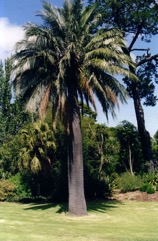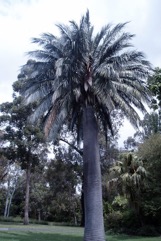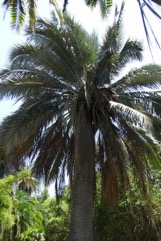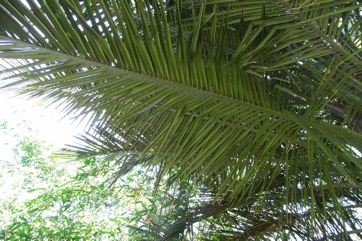Chilean Wine Palm

It suits Mediterranean type climates. They cannot tolerate hot humid tropical conditions. They can grow in temperate conditions. They are hardy to about -6°C. They do best in a sunny position. They can tolerate wind but not salt. They can be grown under most soil conditions. They are drought tolerant once established. In Melbourne Botanical Gardens. It grows to 36°C South in Argentina and Chile. It suits hardiness zones 8-10. Arboretum Tasmania. Hobart Botanical Gardens.
Also known as:
Coquito Nut, Coco de Chile, Honey Palm, Little Cokernut, Palma chilena, Palmera de coquitos
Synonyms
- Cocos chilensis (Molina) Kunth
- Jubaea spectabilis Kunth
- Micrococos chilensis (Molina) Philippi
- Molinaea micrococos Bertero
- Palma chilensis Molina
Edible Portion
- Fruit, Nuts, Seeds, Sap, Palm heart, Cabbage, Seeds - oil
Where does Chilean Wine Palm grow?
Found in: Argentina, Australia, Britain, Chile, Europe, Mediterranean, New Zealand, Russia, South America, Tasmania
Notes: There is only one Jubaea species.
Status: It is a cultivated food plant.
Growing Chilean Wine Palm
Cultivation: Palms can be grown from seed. They need to be sown fresh. The seed are large and need to be sown fairly deeply. The seed germinates erratically. It can take 6 months or a year for seed to germinate.
Edible Uses: The fruit stalk can be tapped for sap. This is distilled to make palm honey. It is also used for wine. The fruit are candied. The nut is eaten. They are also used for oil.
Production: Plants grow slowly. They can take 15 years to produce. The fruit are harvested as they ripen. The nuts or kernels will keep for months if stored dry and cool. Up to 300 litres of sap can be collected over one month from a mature palm.
Nutrition Info
per 100g edible portion| Edible Part | Energy (kcal) | Protein (g) | Iron (mg) | Vitamin A (ug) | Vitamin c (mg) | Zinc (mg) | % Water |
|---|---|---|---|---|---|---|---|
| - | - | - | - | - | - |
Chilean Wine Palm Photos




References
Balick, M.J. and Beck, H.T., (Ed.), 1990, Useful palms of the World. A Synoptic Bibliography. Colombia p 122 (As Jubaea spectabilis), 281 (As Jubaea spectabilis), 474, 499,
Blamey, M and Grey-Wilson, C., 2005, Wild flowers of the Mediterranean. A & C Black London. p 502
Blomberry, A. & Rodd, T., 1982, Palms. An informative practical guide. Angus & Robertson. p 109
Bodkin, F., 1991, Encyclopedia Botanica. Cornstalk publishing, p 595 (Also Jubaea spectabilis - synonym)
Brickell, C. (Ed.), 1999, The Royal Horticultural Society A-Z Encyclopedia of Garden Plants. Convent Garden Books. p 572
Cundall, P., (ed.), 2004, Gardening Australia: flora: the gardener's bible. ABC Books. p 768
Etherington, K., & Imwold, D., (Eds), 2001, Botanica's Trees & Shrubs. The illustrated A-Z of over 8500 trees and shrubs. Random House, Australia. p 406
Facciola, S., 1998, Cornucopia 2: a Source Book of Edible Plants. Kampong Publications, p 29
Gibbons, M., 1993, Palms. Compact study Guide and Identifier. Sandstone. p 47
Gibbons, M., 2003, A pocket guide to Palms. Chartwell Books. p 124
Gouldstone, S., 1978, Australian and New Zealand Guide to food bearing plants. Books for Pleasure. p 46
Gouldstone, S., 1983, Growing your own Food-bearing Plants in Australia. Macmillan p 141 (As Jubaea spectabilis)
Grandtner, M. M. & Chevrette, J., 2013, Dictionary of Trees, Volume 2: South America: Nomenclature, Taxonomy and Ecology. Academic Press p 336
Guzman, E., et al, 2017, A review of the massive Chilean palm. Jubaea chilensis. Caldasia 39(2):183-203,2017
Haynes, J., & McLaughlin, J., 2000, Edible palms and Their Uses. University of Florida Fact sheet MCDE-00-50-1 p 6
Hedrick, U.P., 1919, (Ed.), Sturtevant's edible plants of the world. p 361 (As Jubaea spectabilis)
Henderson, A., Galeano, G and Bernal, R., 1995, Field Guide to the Palms of the Americas. Princeton. p 138
Hibbert, M., 2002, The Aussie Plant Finder 2002, Florilegium. p 174
Hist. pl. 13:397, in adnot. 1895
Janick, J. & Paul, R. E. (Eds.), 2008, The Encyclopedia of Fruit & Nuts. CABI p 131
Johnson, D.V., 1998, Tropical palms. Non-wood Forest products 10. FAO Rome. p 86
Jones, D.L., 1994, Palms throughout the World. Smithtonian Institution, Washington. p 234
Jones, D.L., 2000, Palms of Australia 3rd edition. Reed/New Holland. p 169
Kermath, B. M., et al, 2014, Food Plants in the Americas: A survey of the domesticated, cultivated and wild plants used for Human food in North, Central and South America and the Caribbean. On line draft. p 456
Lord, E.E., & Willis, J.H., 1999, Shrubs and Trees for Australian gardens. Lothian. p 96 (Also Jubaea spectabilis - synonym)
Lyle, S., 2006, Discovering fruit and nuts. Land Links. p 308
Marinelli, J. (Ed), 2004, Plant. DK. p 373
Martin, F. W., et al, 1987, Perennial Edible Fruits of the Tropics. USDA Handbook 642 p 48
Menninger, E.A., 1977, Edible Nuts of the World. Horticultural Books. Florida p 136
Plants for a Future database, The Field, Penpol, Lostwithiel, Cornwall, PL22 0NG, UK. http://www.scs.leeds.ac.uk/pfaf/
Recher, P, 2001, Fruit Spirit Botanical Gardens Plant Index. www.nrg.com.au/~recher/ seedlist.html p 7
Riffle, R.L. & Craft, P., 2003, An Encyclopedia of Cultivated Palms. Timber Press. p 359
Schuler, S., (Ed.), 1977, Simon & Schuster's Guide to Trees. Simon & Schuster. No. 58
Smith, N., Mori, S.A., et al, 2004, Flowering Plants of the Neotropics. Princeton. p 416
USDA, ARS, National Genetic Resources Program. Germplasm Resources Information Network - (GRIN). [Online Database] National Germplasm Resources Laboratory, Beltsville, Maryland. Available: www.ars-grin.gov/cgi-bin/npgs/html/econ.pl (10 April 2000)
Wickens, G.E., 1995, Edible Nuts. FAO Non-wood forest products. FAO, Rome. p167
World Checklist of Useful Plant Species 2020. Royal Botanic Gardens, Kew
www.chileflora.com